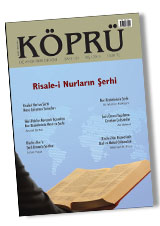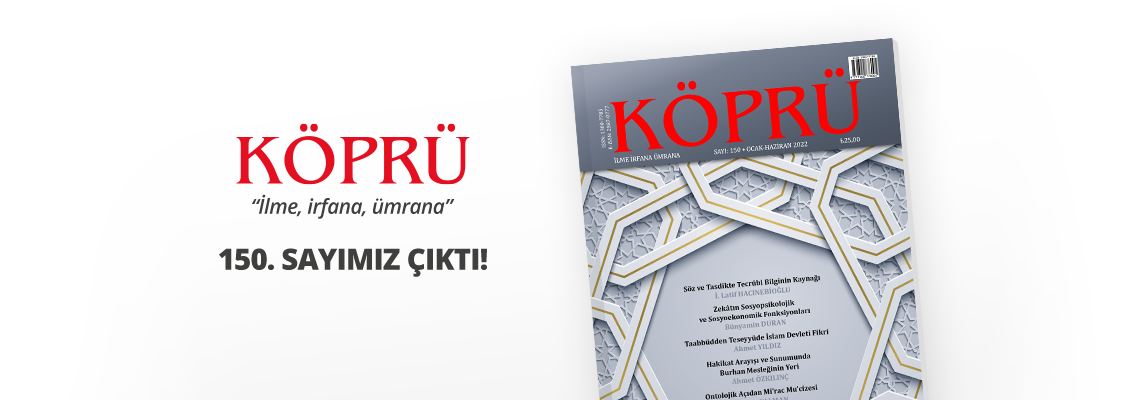Köprü Anasayfa

Risale-i Nurların Şerhi
"Kış 2013" 121. Sayı
-
Editörden
Editorial
Köprü • Sayı: 121 • Kış 2013 • ISSN: 1300-7785 • ss. 5-8
Ahmet Dursun
Editör, Risale-i Nur Enstitüsü
Kur’an-ı Kerim’in bu asırdaki en mühim tefsiri olarak kabul edilen ve Kur’an’dan süzülen damlacıklar olarak tarif edilen Risale-i Nur hakikatlerinin an¬laşılması ve herkese ulaştırılması gereği, son günlerde bir çok alanda yaşanan olay¬larla daha da önem kazanmıştır. Bilhassa, Risale-i Nur’un diliyle ilgili yapılan tar¬tışmalar ve sadeleştirme yönündeki teşebbüsler de meseleyi daha önemli kılmıştır. Bu bağlamda, Risale-i Nur gibi orijinal eserlerin temsil ettiği ruh ve karakterinin korunması ve mesajının daha iyi anlaşılabilmesi için, yapılacak çalışma alanlarının ve metodlarının belirlenmesi gerekmektedir .
Risale-i Nur’un taşıdığı karakter özelliklerinin anlaşılamaması farklı prob¬lemleri de beraberinde getirmiştir. Bu nedenle Osmanlı’dan Cumhuriyet’e geçiş sürecinde kendine özgün ve hususi tefekkür sistematiğini kuran ve bu geçiş sı¬rasında dil, kültür ve medeniyetle ilgili yaşanan bütün kırılmalara da şahit olan Bediüzzaman’ın kullandığı dili bilmek ve korumak, Kur’anî ve Nebevî terminolo¬jiyi konuşma diline aktaran Risale-i Nurların temel hususiyetlerini kavramak, bu eserlerle ilgili yapılacak çalışmaların anahtarı olabilecektir.
Bediüzzaman Said Nursi’nin yol haritasını çizdiği bu çalışmaların hangi alan¬ları ihtiva ettiğini onun “Bu durûs-u Kur’âniyenin dairesi içinde olanlar, allâme ve müctehidler de olsalar, vazifeleri, ulûm-u imaniye cihetinde, yalnız yazılan şu Söz¬lerin şerhleri ve izahlarıdır veya tanzimleridir.” sözlerinde bulmak mümkündür. Risale-i Nur talebelerine tevdi edilen bu görevin sınırlarını belirlemek, yapılacak şerh çalışmalarının metodolojisini ciddi bir usul çalışması ile oluşturmak, Bedi¬üzzaman Said Nursi’nin şerh dışında belirlediği çalışma alanlarını tesbit etmek ve bu yolla Risale-i Nurların orijinal haliyle farklı kesimlere ulaşmasını sağlamak yapılacak çalışmaların özünü ve amacını oluşturmalıdır.
Risale-i Nurlarla ilgili yapılabilecek çalışmalar içinde büyük önem taşıyan şerh ve izah meselesinde bugüne kadar farklı metod ve usullerle çalışmalar yapılmış; ancak bu çalışmalarda bir dil ve metod birliği sağlanamamıştır. Bu nedenle, bu farklılıkların ilmi bir disiplinle giderilebilmesi, bir şerh usulü birliğinin sağlan¬ması, diğer Kuran tefsirlerinden her yönüyle farklı olan Risale-i Nurlar’a ait şerh kriterlerinin ve metodlarının belirlenmesi amacıyla konunun ilmi bir disiplinle ele alınması gerekmektedir. Biz, Risale-i Nur’un şerhinin nasıl yapılacağına dair usul ve prensiplerin de bizzat Risale-i Nur’da bulunduğu tezinden hareketle bu metodolojik çalışmaların yine Risale-i Nur ölçüleri ışığında yapılması gerektiği¬ne inanmakta ve Risale-i Nur kaynaklı bir “şerh yazma klavuzu”nun belirlenmesi gerektiğini düşünmekteyiz. Bu dosya konusunun bu çalışmalara öncülük etmesini ümit ediyoruz.
Köprü olarak bu sayımızda; “Risale-i Nurların şerhi” olarak belirlediğimiz dosya konumuzu bahsi geçen hususlarla birlikte “Risale-i Nur, Risale-i Nur’un dili, tefsir, şerh, tahşiye, izah, tanzim, tertip, tashih, beyan, ispat, tafsil, sadeleştirme, usul, metod” kavramları etrafında tartışmak ve aşağıdaki sorulara cevaplar aramak istiyoruz.
Şerh nedir? Risale-i Nur’un şerhi hangi konu, kavram ve alanları kapsamak¬tadır? Risale-i Nur’u diğer tefsirlerden farklı kılan özellikler nelerdir? Bu bağlam¬da Risale-i Nur’un şerhinin klasik şerhlerden farkları neler olmalıdır? Risale-i Nur’un sahip olduğu dilin temel özellikleri nelerdir? Risale-i Nurun şerhinde dil açısından dikkat edilecek özellikler neler olmalıdır? Risale-i Nur’un şerhinde be¬lirlenecek temel kriterler nelerdir? Bu şerh çalışmalarının usul ve metodu nasıl olmalıdır? Risale-i Nur’un şerhini yapacak kişilerde aranacak özellikleri nasıl be¬lirlemek gerekir? Şerh çalışmalarını yapacak kişiler için bir dil ve yöntem birliği nasıl oluşturulmalıdır? Risale-i Nur’un anlaşılamadığı tezinde hareketle ortaya çı¬kan sadeleştirme teşebbüslerini nasıl değerlendirmek gerekir? Bu bağlamda şerh çalışmalarının önemi nedir?
Risale-i Nurların kavram haritası nasıl çizilebilir? Kavram çalışmalarında be¬lirlenecek usulün temel kriterleri nedir? Risale-i Nur’da şerh edilmesi gereken konular ve bu konuların sırası ve önceliği nasıl belirlenmelidir?
Sizi dergimizle baş başa bırakırken, bu ve benzeri sorulara cevaplar aradığımız bu sayının Risale-i Nurlarla ilgili çalışmalara öncülük etmesini ümit ediyor ve 122. sayımızda tekrar birlikte olmayı diliyoruz.
The necessity of understanding and dissemination of the truths of Risale-i Nur, which is considered as the most important commentary of Quran in this century and which is transcribed as the droplets distilled from Quran, has gained more significance through many incidents happening recently in many areas. In particular the ongoing discussions on the language of Risale-i Nur and the attempts of simplifying it have made the issue much more impor¬tant. In this context it is required that field studies and methods be determi¬ned with the purpose of preserving the essence and character represented by Risale-i Nur and understanding its message better.
Not understanding the characteristic properties of Risale-i Nur has brought up various problems. Therefore understanding the basic properties of Risale-i Nur, which transfers the Quranic and Prophetic terminology to the speaking language, and knowing and preserving the language of Bediüzzaman, who witnessed the breakdowns concerning language, culture and civilization throughout the transition period from the Ottomans to the Republic, and who set up a special systematic thinking model of his own, will have a key role in the studies to be made about Risale-i Nur.
It is possible to find out the areas that should be covered in these studies in the words of Bediüzzaman, “Those who attend the circle of the lessons of Quran, even if they are the highest scholars (allameh and mujtahids) are only expected, with respect to the sciences of iman (ulûm-u imaniye) to carry out the tasks of interpreting, explaining and arranging the Words.” The essence and the purpose of the studies must be to determine the boundaries of the tasks assigned to the students of Risale-i Nur, to establish the methodology of the interpretation studies through a serious examination of procedures, to identify the study areas indicated by Bediüzzaman Said Nursi other than interpretation and thus to enable Risale-i Nur books in their original form to reach different components of society.
The studies made so far with respect to interpreting and explaining Risale-i Nur in different methods and ways, have not attained a standard in terms of language and method. Therefore in order to eliminate the differences, to search for standards and criteria of method(s) of interpreting Risale-i Nur, it is required to deal with the question in a scientific discipline. We believe that the principles and procedures required in this search can be found in Risale-i Nur itself and the methodological studies should be made under the light of the measures in Risale-i Nur. We also think that “a handbook of interpretation” based on Risale-i Nur should be prepared. We hope that the subject of this file will pioneer these studies.
As the subject of this issue of Köprü, we have chosen “the interpretation of Risale-i Nur” and we want to discuss this subject in relation to the concepts of “Risale-i Nur, the language of Risale-i Nur, commentary, interpretation, an¬notation, explanation, arrangement, ordering, correction, exposition, proving, explaining in details, simplifying, way and method” as well as to find answers for questions listed below.
What is interpretation? What subjects, concepts and fields are covered by the interpretation of Risale-i Nur? What are the features that differentiate Risale-i Nur from the other commentaries of Quran? What should be the dif¬ferences of the interpretation of Risale-i Nur from the classic interpretations? What are the basic features of the language of Risale-i Nur? What language features must be taken into consideration in the interpretation of Risale-i Nur?
What are the basic criteria that are to be used in the interpretation of Risale-i Nur? What should be the methods and ways of interpretation studies? What properties should be sought in the interpreters of Risale-i Nur? How can we establish standards for the language and methods to be used by the interpreters? How can we evaluate the attempts of simplifying Risale-i Nur with the premise that it has not been understood? What is the significance of interpretation studies in this context? How can the map of concepts in Risale-i Nur be drawn? What are the basic criteria to be used in studying concepts? How can we determine the order and the priority of the topics to be interpre¬ted in Risale-i Nur?
As we invite you to enjoy our periodical we hope that this issue of Köp¬rü, where we look for the answers of the above and similar questions, pioneer the studies related to Risale-i Nur and we wish to meet you in the 122nd issue.
-
Editörden
Ahmet Dursun
Yazıyı okumak için tıklayınız... -
Risale-i Nur EnstitüsüRisale-i Nurların Şerhi Konulu Masa Çalışması
Risale-i Nur Enstitüsü
Yazıyı okumak için tıklayınız... -
Şerh Öncesi Yapılması Gereken Çalışmalar
Ali Bakkal
Yazıyı okumak için tıklayınız... -
Risale-i Nur’un Şerh, İzah ve Sadeleştirilmesi
Musa Kâzım Yılmaz
Yazıyı okumak için tıklayınız... -
Nur Risaleleri’nin Şerhi
M. Muhsin Kalkışım
Yazıyı okumak için tıklayınız... -
Risale-i Nur’u Şerh Etmenin Şartları
İslâm Yaşar
Yazıyı okumak için tıklayınız... -
Risale-i Nur Hizmetinde Usul ve Metot Çalışmaları
Mehmet Ali Kaya
Yazıyı okumak için tıklayınız... -
Risale-i Nur’un Şerh Çalışmaları İçin; Esnek Bir Yöntembilimsel Teklif
İbrahim Kaygusuz
Yazıyı okumak için tıklayınız... -
Fikrî Haklar Mevzuatı Açısından Nur Risalelerinin Neşri ve Şerhi
Ahmet Battal
Yazıyı okumak için tıklayınız... -
Risale-i Nur’un İzah Metodolojisi Üzerine Bir Tasnif Girişimi ve Şerhin Önündeki Maniler
Ömer Said Güler
Yazıyı okumak için tıklayınız... -
Risale-i Nur’da Bir Kavram: Mucize-i Manevî
Abdulhalim Bilici
Yazıyı okumak için tıklayınız... -
Risale-i Nur Külliyatı’nda Edebî Şerhlere Dair Bir Giriş Denemesi
Zübeyir Kaplan
Yazıyı okumak için tıklayınız... -
Risale-i Nur’un Risale İle İzahı Konusal Bir İzah Denemesi: Dördüncü Mesele Örneği
Atilla Yargıcı
Yazıyı okumak için tıklayınız... -
Neşrinin 100. Yılında Münazarat Şerhi Denemesi Metin ve Şerh 3 Neden Münazarat
Levent Bilgi
Yazıyı okumak için tıklayınız... -
Risâle-i Nur’dan seçmeler
Bediüzzaman Said Nursi
Yazıyı okumak için tıklayınız...
